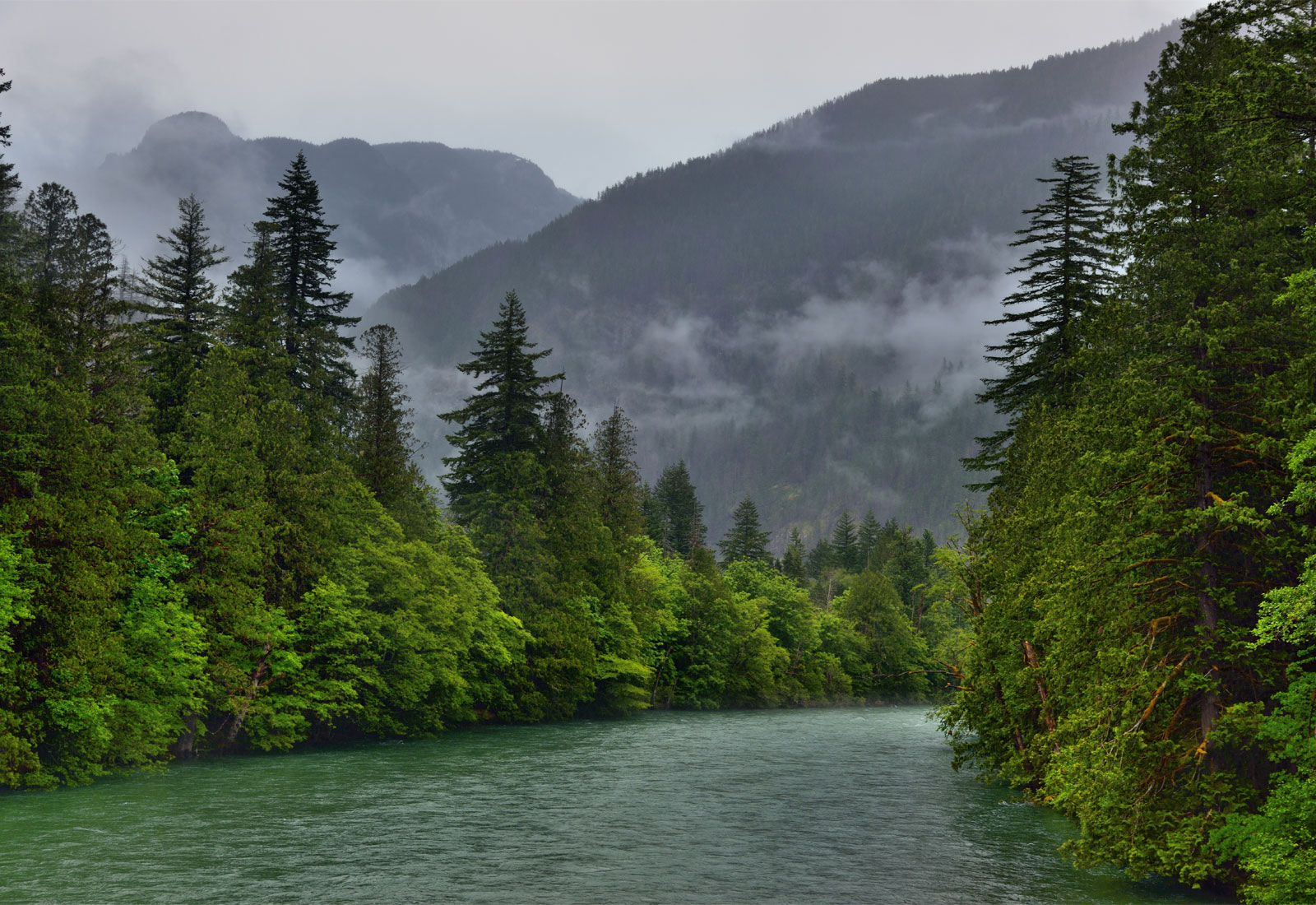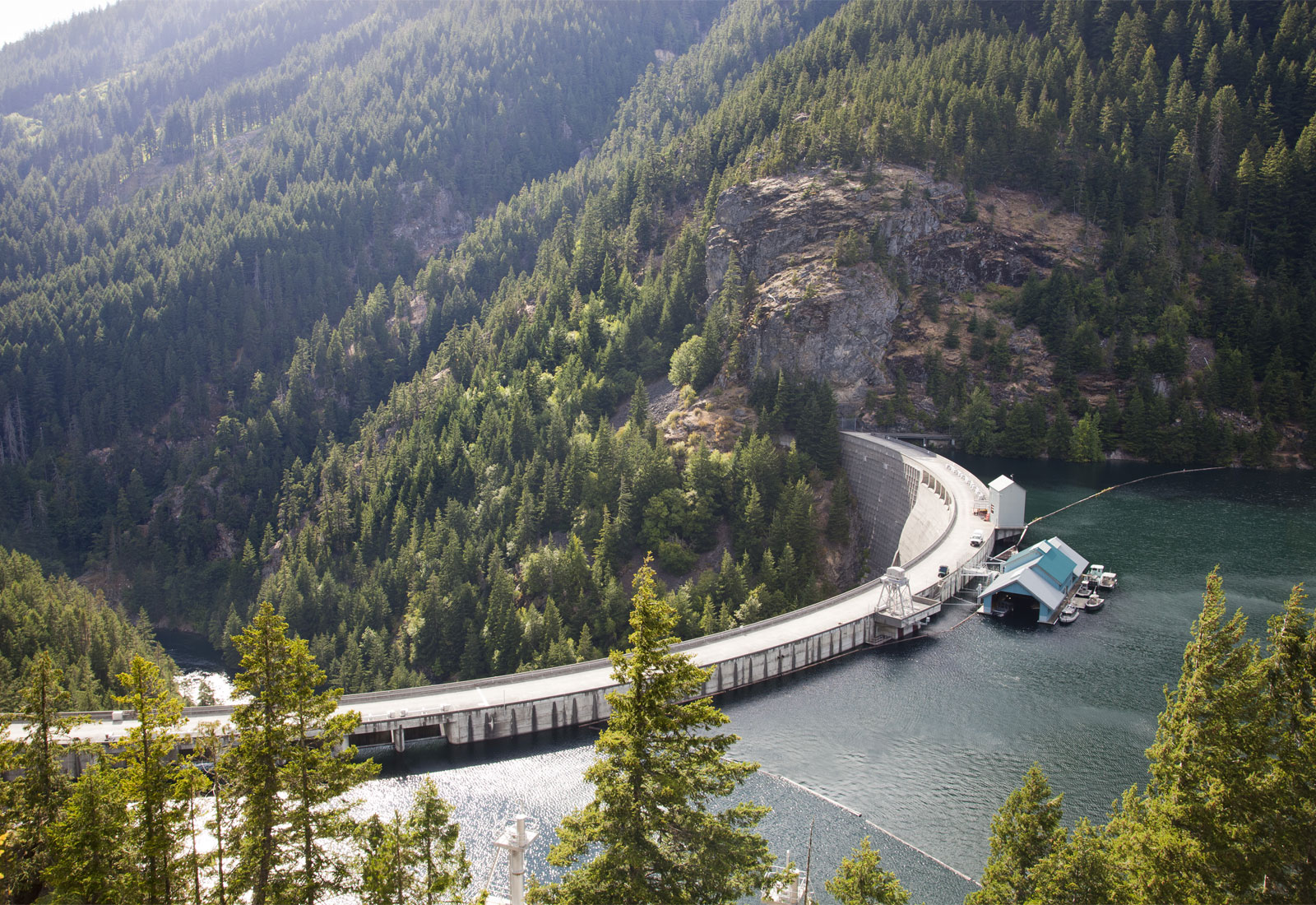Jack Fiander knew he needed to try something different. For months, Fiander, a member of the Yakama Nation and legal counsel for the Sauk-Suiattle Indian Tribe, had been trading lawsuits with Seattle over the city’s hydroelectric dams. “Seattle’s not hearing what we’re saying,” he realized. “Maybe they, and the public, need to understand more about Tribal culture.”
For over a century, salmon populations have been declining in the Skagit River in Northwest Washington State and the Sauk-Suiattle Tribe say three hydroelectric dams are responsible. Last year the tribe sued the City twice over the dams, first claiming Seattle is engaged in “greenwashing” by calling the project the “Nation’s greenest utility,” despite strong contradictory evidence. Then again claiming the city violated Federal and state law by refusing to install fish passages. Neither has led to any increased protections for salmon.
But with the dams in question in the midst of a relicensing process that could extend their life by another fifty years, Fiander realized he had a fresh opportunity to fight back, and in January, he filed a third lawsuit, this time with a new strategy. In Sauk-Suiattle Tribal Court, he sued Seattle on behalf of salmon, Tsuladxw in the Sauk-Suiattle language, alleging that the city’s hydroelectric dams violate the salmon’s rights.
“Tsuladxw, our relatives under on water, are the most important cultural and sacred food of the Sahkuméhu [Sauk-Suiattle people] and have been a part of our traditional stories, teachings, lifeways and spirituality since the earliest times to the present day,” the complaint reads. “For the Sahkuméhu, Tsuladxw is sentient like all living creatures and they are our relations.”
The lawsuit seeks declaratory relief that salmon have the inherent right to “flourish”, that the Tribe has a right and responsibility to protect salmon, and that the city is engaged in intentional violation of these rights.
“Tsuladxw depends on clean, abundant fresh flowing waters and the nutrients they carry and which important and essential natural ecosystem resources have been under constant threat from defendant’s activities,” the complaint continues.
The case, which relies on a concept known as Rights of Nature, is an important test of what Indigenous law experts say could become a powerful tool for tribes to defend their sovereignty and the non-human relatives. Rights of Nature laws acknowledge that animals, water, and their ecosystems have inherent rights that must be protected and are equivalent to fundamental human rights like the right to exist freely and safely. They also acknowledge that ecosystems and animals with Rights of Nature are entitled to legal representation by groups with knowledge and investment in their protection.
The Sauk-Suiattle believe it is their responsibility to protect salmon. In response, Seattle has sued the Tribe back, arguing that the Sauk-Suiattle Tribal court has no jurisdiction over the city.
The growing rights of nature movement codifies beliefs that many Indigenous communities have held for thousands of years. But in the United States, they’re raising bigger questions: Can Indigenous worldviews help protect the environment? And will the American legal system let them?

For hundreds of years, treaty law – legally binding agreements negotiated between Indigenous nations and the United States – has been the primary law governing relationships between tribal, state and federal governments. In many cases, treaties created property rights, service obligations, and retained crucial rights to land, hunting and fishing. Most treaties were signed under duress, meaning tribes had to accept less than ideal terms, but the Constitution holds that treaties are the “the supreme law of the land”, and for generations, have been one of the only legal options tribes have been able to employ. Experts say Rights of Nature may offer a new legal avenue to Indigenous nations.
In 2006, Tamaqua Borough, Pennsylvania, became the first known community to pass a rights of nature law after giving legal rights to the local ecosystem in order to ban hazardous waste dumping. Thomas Linzey, senior legal counsel for the Center for Democratic and Environmental Rights, helped craft the law, and since then, countries and communities around the world have adopted similar Rights of Nature laws to protect the environment.
In 2008, Ecuador became the first country to recognize the rights of Pachamama, or Mother Nature, in its constitution. And three years later, the law became the basis of a lawsuit against a company dumping construction waste in a river. Largely led by Indigenous communities, other countries like Colombia and New Zealand have also adopted Rights of Nature laws.
In 2018, the White Earth Band of Ojibwa recognized the rights of Manoomin, or wild rice, to “exist, flourish, regenerate, and evolve, as well as inherent rights to restoration, recovery, and preservation.” Rights of Manoomin, which means “good berry,” was the first Tribal law to grant legal rights to a plant or animal.
“In our culture, wild rice is the most significant, central part of our culture. It’s the most central part of our spirituality,” said Frank Bibeau, attorney for the White Earth Ojibwe.
In 2021, White Earth sued the State of Minnesota on behalf of Manoomin to stop Enbridge, a Canadian energy company, from using billions of gallons of water in its construction of an oil pipeline. Enbridge’s Line 3 pipeline expansion has met fierce resistance from the Ojibwe and other Indigenous and non-Indigenous land and water protectors. Over its fifty-four year history, the pipeline has suffered from a series of oil spills, including a 1991 incident that was the worst inland oil spill in US history. The lawsuit was the first attempt by a Tribe to enforce a rights of nature law and is currently awaiting a decision from a Federal Appeals court that will decide if it will be heard in Tribal court. The decision could impact the Sauk-Suiattle case and other tribal Rights of Nature cases, but differences in treaties and state laws mean that each case faces its own unique circumstances and challenges.
Bibeau believes that Rights of Nature lawsuits have the potential to shift the balance of power between tribes and state governments when it comes to environmental protection and create a situation where states like Washington and Minnesota opt to negotiate with tribes out of a desire to avoid litigation. “If you want our consent then you’re going to have to start making things better and cleaner and show us that,” he said. “We just can’t let it happen.”
In the Sauk-Suiattle case, Bibeau sees a potential turning point for the Rights of Nature movement in the United States. People have a visceral reaction to dying salmon, Bibeau says, that can help them understand a concept like Rights of Nature in a way that something more obscure like wild rice cannot. Because of this, he says the case has the potential to bring even more attention to the legal concept of Rights of Nature. “I suspect that the model that Sauk-Suiattle is using will become the real template for most of the Indian tribes because everybody knows that a fish needs clean water,” he explained. “Everybody knows what a thousand dead fish look like and they immediately jump to the conclusion that there’s something wrong with that water.”
Matthew Fletcher is Director of the Indigenous Law & Policy Center at Michigan State University and member of the Grand Traverse Band of Ottawa and Chippewa Indians. “Treaty law is the law of the colonizer. It’s American law. This is what the United States is willing to accept and acknowledge. And on a fundamental level, it’s not enough. So the tribes are adopting a theory that’s rooted in their cultures,” Fletcher said.

The litigation between the Sauk-Suiattle Tribe and the city comes as Seattle City Light navigates a years-long relicensing process with the Federal Energy Regulatory Commission (FERC). The current 30-year license expires in April 2025. The new application, if granted, could extend the license as long as 50 years. At a minimum, the Sauk-Suiattle hope that a new license will provide better fish protections, but without a license, the dams could be removed.
The Sauk-Suiattle lawsuit claims that three dams – The Diablo, Gorge, and Ross Dams – are harming salmon populations. The dams make up the Skagit River Hydroelectric Project in Northwest Washington State, about 100 miles from Seattle, which provides roughly 20% of the city’s total electricity. Unlike many other hydroelectric dams, these three do not include pathways for fish to move around the massive structures.
The dams limit the flow of water, which reduces the flow of nutrients and other vital aspects of the river’s ecosystem, says Fiander, and is especially catastrophic for species like salmon, which rely on those areas to spawn. Tribes and other environmental groups also allege that the dams prevent salmon from reaching upstream parts of the river that they could before the dams were built. However, Seattle City Light claims that those parts of the river were already difficult for salmon to access due to natural impediments.
Since the dams’ last relicense in 1995, three fish that call the area home — chinook salmon, steelhead, and bull trout — have been listed as “threatened” under the Endangered Species Act. Orcas, which rely on salmon as a food source, are also endangered. Jack Fiander, the Sauk-Suiattle Tribe’s legal counsel, says that these ripple effects are a perfect illustration of why Rights of Nature laws are important. Rights of Nature, he says, are an acknowledgement that everything is connected. Protecting salmon helps protect the river, the orcas, and the people living near them. “It’s not meant to be mystical,” he said.
Fiander says that relicensing is an existential crisis for both salmon and the Tribe. “If these three dams get licensed for another 50 years without some consideration or requirement of getting fish past those dams to access habitats, the salmon in that river are probably going to be extinct in ten years,” he said.
But Chris Townsend, Director of Natural Resources and Hydro Licensing for Seattle City Light, disputes claims that City Light is not doing enough to protect salmon. “The Skagit River is one of the healthiest runs of Chinook left in Puget Sound. Particularly the area just below our dam. So we’ve been doing something right with the flows,” he said.
Fiander maintains that the salmon are clearly suffering from the dams. “The dams provide electricity, but they are blocking all kinds of nutrients and sediments behind them that the river needs for its life,” he said, adding that just one fish passage could make a huge difference for salmon.
Townsend, however, said that it is too early in the process to say what measures are required to protect the river and its wildlife. “Those decisions have to be based on science,” he said.
Debra Smith, the general manager of City Light, has said that the utility is committed to building fish passage if the regulatory agencies indicate that it is necessary while Townsend says that City Light is open to a conversation about Rights of Nature. “We look forward to the point when we can talk and coordinate with the Tribes more directly when the lawsuits have been resolved and we hope that that will be soon,” he said.
Fiander says that despite City Light’s public statements, they are not negotiating in good faith and are trying to overwhelm him with corporate legal tactics.
After criticism of its initial study plan, City Light’s revised study plan was approved, with some modifications, by FERC in July 2021. The new plan proposed 33 studies related to flood risk, fish population, water quality, and more. City Light will release its initial report findings at the beginning of March. The final application is due April 2023.

Other Tribes and environmental groups have also pushed back on City Light’s environmental claims. The Upper Skagit, who share treaty rights to Skagit River with the Sauk-Suiattle and the Swinomish Tribe, have also resisted City Light’s plans, asking for a study to consider removing Gorge Dam.
Tribal advocates see the city’s efforts to fight the Tribe as evidence that they are not prioritizing the project’s environmental impact. “If Seattle was behaving in an environmentally ethical manner, they would address the Tribe’s claims in a serious manner,” Matthew Fletcher said.
The Tribe is currently awaiting Federal court ruling on their litigation, like the White Earth Ojibwe. Win or lose, Frank Bibeau believes the cases are an important step toward getting the U.S. legal system to embrace Rights of Nature. “It’s probably the most powerful tool we’ll ever have. And that may be all the power we need if we can just get it harnessed and use it as a shield and a sword to make the state operate in a better way for everybody,” he said.
For Jack Fiander, the case rests on the simple concept that salmon deserve the right to live and be defended. As long as that right is at risk, the Sauk-Suiattle will continue doing everything they can to protect salmon and the river. “Certain animals in nature are connected to us and are sentient beings,” he said. “It’s something I was taught since childhood.”



